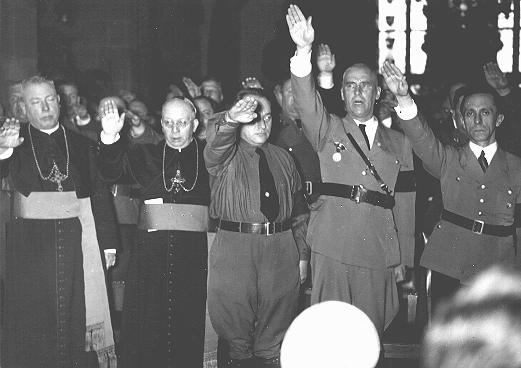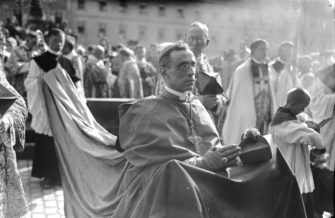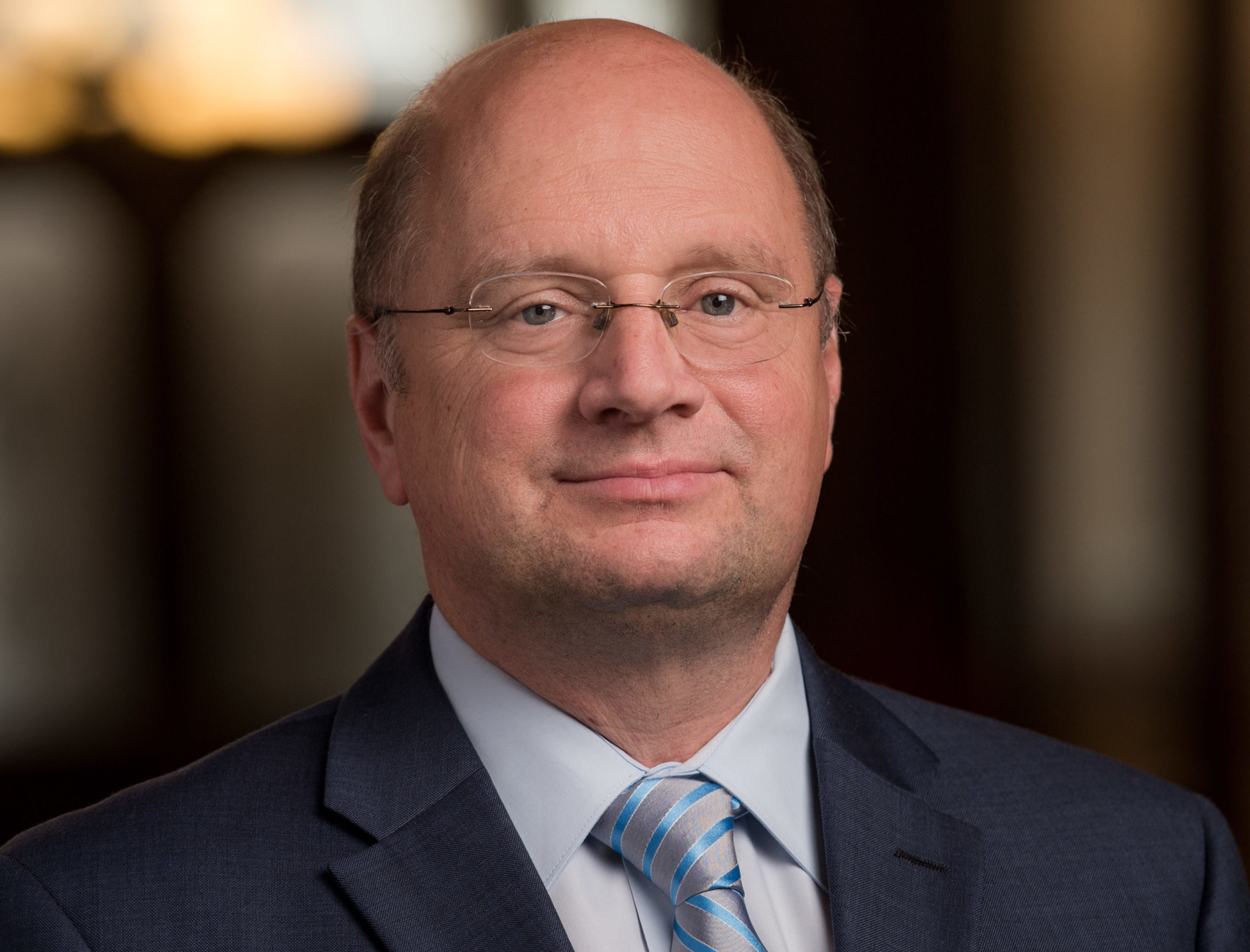
The muffled applause you hear emanating from U.N. headquarters, and from the diminishing number of world capitals whose leaders still believe, is offered in quiet celebration of the centennial of the creation of the League of Nations, in 1920. Ah, what a time it was for the internationalists of every stripe! A year earlier, in 1919, Lenin had founded the Comintern in Moscow; not to be outdone, his rivals for leadership of “world labor” established their own Labor and Socialist International four years later. Around the same time, fledgling non-communist democratic parties across Europe began finding one another, and decided to jump aboard the “crossing borders” bandwagon; in 1925, they grouped together under the non-pithy banner of The International Secretariat of Democratic Parties Inspired by Christianity.
Most of these contenders, save the Communist International, turned out to be pretenders. Bereft of a hardy universalist ideology to sustain their ambition and blunt fissiparous infighting, they sputtered after a season or so in the sun. Only one nations-based transnational organization, an experienced one at that, had the vision, the ideology, and the cadres of devout to give Moscow a run for its money as a would-be world hegemon—the Roman Catholic Church. When it took shape at the height of the First World War, Catholic Internationalism, writes Giuliana Chamedes, was “a set of practices (crossing borders, forging connections), a way of seeing the world, and a vision for the future. Its claims dovetailed well with the Church’s longtime espousal of universalism . . .[and] its purpose was to use new and technologically advanced means to centralize power and glue members to Rome, even as it provided an infrastructure for increased sociability within national bounds” (6).
In A Twentieth-Century Crusade, her new history of Vatican diplomacy and statecraft from 1914 to 1960, Chamedes details how all the Pope’s men sent about to reclaim Europe from the clutches of aggressively secular-liberal forces, first through a series of concordats (bilateral treaties recognized by international law) with sympathetic Catholic nation-states and early “marriages of convenience” with right wing ethnonationalists emerging in Germany, Austria, Poland, Italy, and Spain; and, then, in the 1930s, through a transnational (eventually global) campaign to counter “atheistic Communism” —Catholic schoolchildren never knew it as mere “Communism”—via alliances with (anti-liberal, antisemitic) fascist regimes, support for anti-communist lay activist networks, and the suppression of anti-fascist Catholic leaders.
The strategy, Chamedes notes, was remarkably effective. While not quite endorsing the claims of Catholic partisans at the time that Rome had become “’the seat of the mightiest Internationale the world has ever seen,’” she concludes that the Vatican “did not lose the battle with modernity,” but rather militated effectively against the separation of private and public spheres in much of Europe and “successfully de-privatized religion” during the interwar years (6–7).
In A Twentieth-Century Crusade, her new history of Vatican diplomacy and statecraft from 1914 to 1960, Chamedes details how all the Pope’s men sent about to reclaim Europe from the clutches of aggressively secular-liberal forces, first through a series of concordats (bilateral treaties recognized by international law) with sympathetic Catholic nation-states and early “marriages of convenience” with right wing ethnonationalists.
Grounded in extensive archival sources, Chamedes’s history is particularly strong in demonstrating how the concordats and related socio-political negotiations, settlements, and strenuously cultivated relationships between Church and state officials were designed to weave a thick web of collusion across key dimensions of cultural, civic, and “private” life. The goal was to ensure not only ecclesiastical privilege in the partner states, but also enforcement of the Church’s teachings on marriage, divorce, education, religious observance, and the status of religious “outsiders” (i.e., Jews and Protestants) in return for the legitimacy afforded the regimes by the Church’s endorsement.
Fascist atrocities during the Spanish Civil War and World War II did not move the Church to recalibrate the basic strategy informing Catholic Internationalism; so intent was the Vatican on “protecting the Church” that even the horrors of the Holocaust, not lost on Pope Pius XII, failed to scandalize Catholic diplomats and other officials into reconsidering the rights of religious minorities and championing religious freedom.
Not all Catholics overlooked the tragic dimensions of the Vatican’s focus on ecclesiastical prerogatives, of course; as historian James Chappel has shown and Chamedes acknowledges, as early as the 1930s a generation of lay Catholic intellectuals, along with a number of pioneering priests and theologians working independently of the Vatican, took up pressing questions of labor, economics, and politics “from below,” thereby retrieving and updating an earlier Catholic approach to the social order and laying the groundwork for what Catholics of the period following the Second Vatican Council (1962-’65) would refer to as the Church’s “social justice” mission.
. . . So intent was the Vatican on “protecting the Church” that even the horrors of the Holocaust, not lost on Pope Pius XII, failed to scandalize Catholic diplomats and other officials into reconsidering the rights of religious minorities and championing religious freedom.
And, in one of the ironies that fascinates students of Catholicism—not least, because they are not quite ironies but, rather, the reconciliation of seeming paradoxes embedded in the Church’s spiritual DNA—Pius XII himself promulgated two encyclicals in 1943 which eventually served to undermine, or at least contest, the notion of the Church as a worldly hegemon rather than a (merely) spiritual kingdom. The encyclicals were Mystici Corporis Christi, which promoted the Biblical image of the Church as a mystical communion—not merely, or even primarily, as a hierarchical institution; and, Divino Afflante Spiritu, which authorized new translations of the Bible into vernacular languages, and cautiously opened the way for “critical,” historically informed biblical studies.

Owing in part to these emerging alternatives, and to the postwar rise of Christian Democratic parties across Western Europe, which established a measure of independence from Rome, the Catholic Internationale eventually lost steam and collapsed.
All of this raises trenchant questions for Catholics trying to make sense of—account for—the Church’s scandalous dalliance with fascism and antisemitism. How could “the Bride of Christ,” the “perfect, unblemished eternal society,” “the kingdom of God on Earth”—labels for the Church familiar to Catholic parochial school students during the period in question, and beyond—fail so egregiously to uphold the standards of basic human decency, not to mention fundamental principles and tenets of Christian ethics?
Catholic intellectuals seeking to address this puzzle might take a page from the writings of Atalia Omer, whose struggles with the mounting ethnoreligious nationalism and socio-political exclusivism of Zionism led her to call for the constructive reimagining of Jewish identity and the reframing of the Jewish ethical compass. Are Catholic scholars of religion, in particular, called to the role of “critical caretaker” of their own contested, internally plural, ethically ambiguous, and yet spiritually profound tradition? Their religious, cultural, and historical acumen seem poised to serve the goals of analysis, understanding, and “explanation,” yes, but also recovery and renewal.
How could “the Bride of Christ”. . . fail so egregiously to uphold the standards of basic human decency, not to mention fundamental principles and tenets of Christian ethics?
A big and complicated project, to be sure. But let us begin to sketch its outlines, modestly, by extrapolating beyond Chamedes’s crisp analysis, with its necessary focus on high-level diplomacy, national politics, Vatican intrigue, and the mobilization and social organization of Catholic anticommunist youth movements and related organizations. While Chamedes in her attention to these topics does not overlook the piece of the puzzle which millions of twentieth century Catholics would grasp intuitively as its centerpiece, she does not quite capture its explanatory significance. I refer to the priority of belief—in this case, the widespread, bred-in-the-bone belief in the supernatural as the controlling and ordering reality, a matter of faith held reflexively and, well, infallibly, by Roman Catholics of the era. Absent a feel for the metaphysical import of the Catholics v. Commies drama—this was a face-off of the highest consequence: Good v. Evil, God v. Satan—one cannot fully understand the extremes to which the Church was willing to go in order to prevail.
Absent a feel for the metaphysical import of the Catholics v. Commies drama—this was a face-off of the highest consequence: Good v. Evil, God v. Satan—one cannot fully understand the extremes to which the Church was willing to go in order to prevail.
Here is the hard core of the tradition with which the critical caretaker of “the Catholic thing” (in Rosemary Haughton’s memorable phrase) must grapple: we Catholics really believed in spirits and angels, virgin births and a crucified god, Heaven and Hell—and in the utter inconsequence of merely mundane politics and earthly travails when measured against the fate of the immortal soul. What is more, and perhaps more difficult for “merely” secular scholars (those not infected with the crazy-making virus of hard-core religious belief) to accept: even the popes and scheming prelates and professional diplomats and worldly bureaucrats were, first and foremost, true believers. This does not mean that their machinations were not also about power. But the calculus of power, this argument goes, was different than, say, Lenin’s or Stalin’s. And it was this overweening religious imaginary which sniffed out, correctly, that the ultimate threat was not mere mundane fascism, with its nominally theistic sympathies, but rather atheistic communism—“the earthly face of Satan himself,” as Chamedes rightly puts it (5).
The Catholic scholar who is critical caretaker would also employ her historical literacy to recognize and underscore the fact that the Vatican had been preparing for this cosmic struggle long before the Comintern threw down the internationalist, world-hegemon gauntlet. Decades before Chamedes begins her story, the Bishop of Rome had elected to sacralize and enforce the affinity between revealed Truth (encoded in creed, ritual, and dogma—the objects of “belief” for Catholics), on the one hand, and the institutional Church, in its rigidly hierarchical and ultramontane authority structure, on the other. As Ann Taves documents in her history of Roman Catholic devotional practices in mid-nineteenth century America, The Household of Faith, an earlier Pius (Pope Pius IX, who reigned from 1846 to 1878) had employed “modern technologies,” especially mass-produced printed devotional manuals, laced with prayers for the Supreme Pontiff alongside invocations of the saints, as part of his campaign to set the Church decisively against the forces of liberalism and secularism. Distributed across the Catholic world within and beyond Europe, the pamphlets helped to conflate, in the popular Catholic imagination, the prerogatives of the pope and the heart of the faith itself.
The Catholic scholar who is critical caretaker would also employ her historical literacy to recognize and underscore the fact that the Vatican had been preparing for this cosmic struggle long before the Comintern threw down the internationalist, world-hegemon gauntlet.
The next Pius who came along (Pope Pius X, 1903–1914 as pope) made abundantly clear that new respect in modern secular culture afforded to the individual subject and personal experience was an error no less pernicious than the wooly-headed notion that non-Catholics had a right to vote in a properly ordered democracy. On September 8, 1907 the Vatican published the encyclical Pascendi Dominici Gregis: On the Doctrines of the Modernists, one in a series of official documents and rulings promulgated during his pontificate as part of a sustained crusade against “modernism,” which Pascendi called “the synthesis of all heresies” (para. 39). Subsequently, priests were required to swear an oath against modernism, and vigilance committees were established in dioceses around the world to root it out. At stake was no less than church-state union, the radical transcendence of the Divine, and the authority of the Church.
According to the pope, God’s absolute sovereignty over human affairs was being compromised by certain modern Biblical exegetes and critical historians whose writings downplayed, or even denied outright, external or “extrinsic” revelation from God, in favor of human “experience” as the source of sacred truth. Holy Scripture and Church dogma have emerged over time as the result of evolving human awareness under shifting circumstances. The sources of revelation, in short, were reduced to fallible historical artifacts subject to “development.” Were the modernists to prevail, Pascendi warned, the authority of the magisterium or (and, by extension, the infallibility of the pope) would be threatened; so, too, would the “properly ordered” political society.
These earlier chapters in the history of Catholicism’s turn to technologically enhanced, modern forms of authoritarianism provide a key to interpreting the alliance with fascism. The parallels between the wielding of power by authoritarian fascist leaders and by the nineteenth and early twentieth-century popes, who rejected what they saw as the “absolute madness” of religious freedom and religious pluralism, have not gone unnoticed by historians of many and no religious backgrounds.
Perhaps it falls to critical caretakers of the Catholic tradition, then, to recover and recuperate Catholic narratives, histories, and self-understandings which, while grounded in enduring marks of the tradition such as the priority of belief, resisted narrow and absolutist interpretations of how such affirmations might be understood and practiced.

